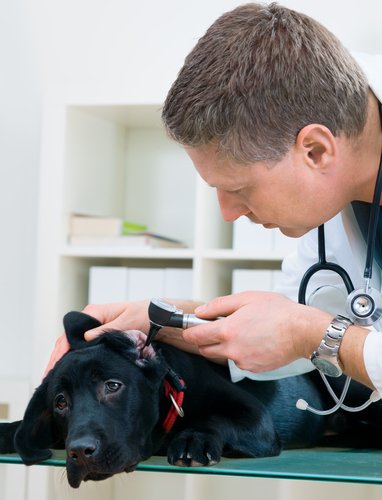Hot Spots on Dogs

Hot spots are known in the medical world as acute moist dermatitis. They have this name because the lesions can feel hot when you put your hand near them. It’s quite a common pathology in veterinarian clinics. They are irritations on the skin that cause dogs to constantly scratch themselves and can cause hot patches.
Where hot spots are located
Anything that causes irritation on your dog’s skin can give rise to hot spots. Allergies, stings, scabies, cuts, scratches or dryness can cause itchy skin.
This itchiness causes the animal to scratch vigorously and damage their skin. Even infections in the ear or anus can cause the dog to voluntarily scratch.

These lesions cause a lot of discomfort. When the wound is infected, the dog scratches and licks it. This infection quickly becomes a wet and hairless circle that can ooze pus. They are deep lesions that can appear as an open wound or covered with a scab, which will give off a bad smell.
The signs of hot spots tend to be seen more often on a dog’s cheeks, hips, chest, and head. Logically, in places where they can scratch.
The only way to prevent the appearance of hot spots on dogs is by preventing any factors that could irritate their skin. It’s advisable to carefully check your pet if you notice that they’re scratching themselves frequently.
How to treat hot spots on dogs
You will need to take your dog to the vet in order to treat them. Hot spots are lesions with bacterial infections that often require the application of medications in order to be treated. In addition, because of the pain, the dog can react aggressively when the injury is touched.

Hot spots grow rapidly. In a few hours, they can considerably increase in size. Acting quickly will prevent them from spreading and getting worse.
The treatment of hot spots in dogs should be directed both towards curing the infected lesions and eradicating their cause. This is why it’s important to know what caused the dog to scratch from the beginning.
The process begins with shaving the hair around the wound in order to expose the inflamed area to the air and to know how far it extends. Afterward, the wound is cleaned and disinfected by using an antiseptic.
Special products can be used to dry the lesion. The wound must be kept open to the air and must be constantly monitored to make sure it doesn’t get any worse.
Based on the severity of the injuries, the veterinarian will determine if it will be necessary to administer antibiotics as well as anti-inflammatories and analgesics.
After treating the lesions
It may not be necessary to go back to the veterinarian to check the lesions. However, everything will depend on how severe the wound is. Most likely, the specialist will tell you how to clean the wounds at home, as well as how to administer the treatment.
Surely, it will be necessary to make the dog wear an Elizabethan collar to keep them from licking and scratching the wounds. Keeping the dog entertained with toys and exercise can help prevent them from thinking about the discomfort that comes from the wounds.
Once treated, hot spots on dogs can improve within a matter of a few weeks. Even though your dog will be left with scars, it really isn’t that common.
Prevention
You can take some measures to minimize the chances of your dog suffering from hot spots.
- Clean your dog frequently. If they are from a long-haired breed, you should try to keep their fur short, especially in hot weather.
- Use products to eliminate fleas and ticks in the places where the dog spend their time at. It’s also good to bathe them on a regular basis with shampoos that repel these parasites.
- If you notice that they’re scratching a lot and it seems to bother them, then you should carefully check their skin for any injuries or bites.
- Monitor their diet to make sure they don’t have any food allergies.
- Make your dog exercise on a daily basis. Boredom can cause anxiety, and this can trigger episodes of scratching and licking that produce skin lesions.
Take your pet to routine veterinary check-ups to verify that they don’t have any disorders that are hard to detect. Any pain or discomfort could lead to scratching.
All cited sources were thoroughly reviewed by our team to ensure their quality, reliability, currency, and validity. The bibliography of this article was considered reliable and of academic or scientific accuracy.
Paterson, S. (2014). Acute moist dermatitis. Companion Animal. https://doi.org/10.12968/coan.2014.19.7.350
Olivry, T., DeBoer, D. J., Favrot, C., Jackson, H. A., Mueller, R. S., Nuttall, T., & Prélaud, P. (2015). Treatment of canine atopic dermatitis: 2015 updated guidelines from the International Committee on Allergic Diseases of Animals (ICADA). BMC Veterinary Research. https://doi.org/10.1186/s12917-015-0514-6
